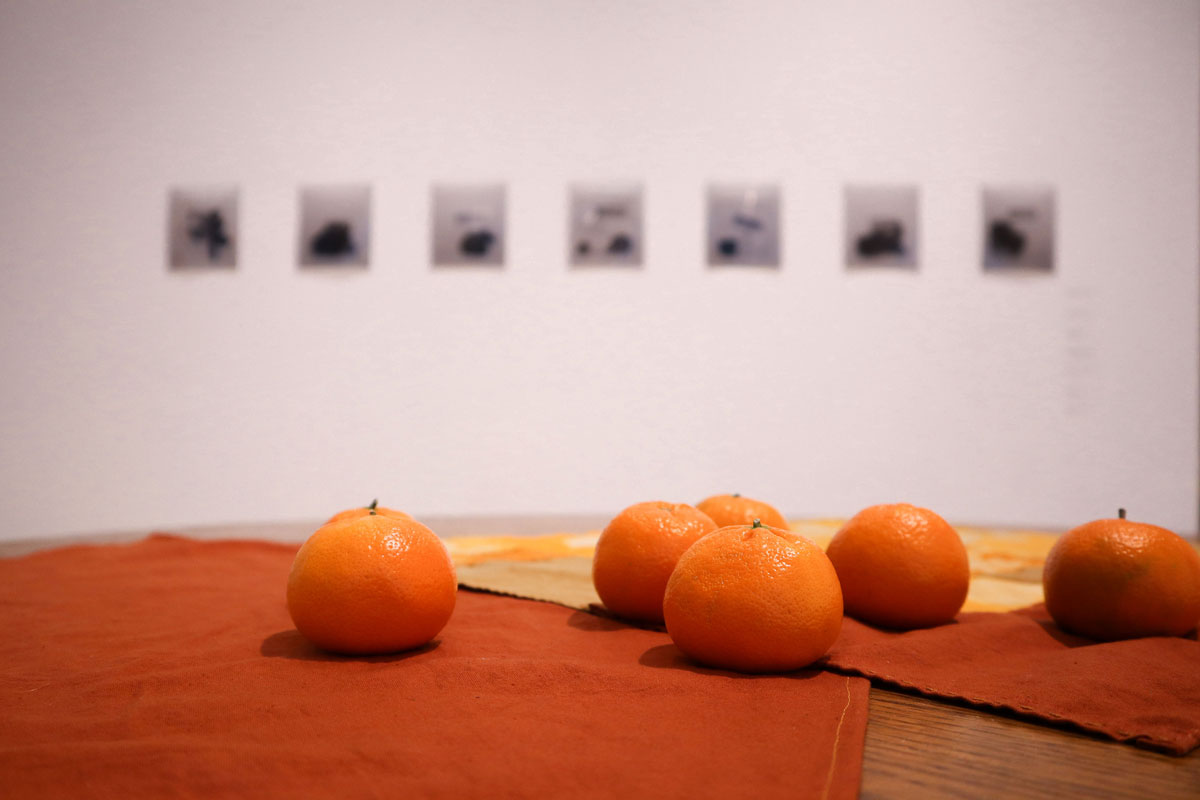Crates of tangerines are neatly stacked upon each other in front of a window display. If hurrying past, I would mistake this crammed and narrow space for a small market in Vancouver’s Chinatown, but my curiosity is piqued by the polite arrangement of branded crates and tangerines which are deliberately placed on a bench. Entering the space, there is a sense of affection and care in the placement of the objects laid bare for a viewer’s meditation – this is not a market selling discounted fruit.
Toronto-based artist Seooyeong Lee’s exhibition, the tangerine project, at Access Gallery, presents a body of work which humbly explores love, trauma, and community. Lee’s exploration materializes in neatly composed photographs and installations from ephemera of past happenings. Almost appearing as sketches, Study of a Tangerine (2022) and Study of Tangerines – Version 2 (2022) capture the decomposing gestures of tangerines. Historically, artists have used carefully arranged fruits as studies of light and dark, composition, and social commentary, which often demonstrated tribute to the arts and an opportunity for an artist to express their painterly virtuosity. Further artistic discourses also consider memento mori, an artistic trope that reminds viewers of our inevitable death and that any moment could be our last. Viewing these photo- graphs, I could not help but wonder, why is Lee attempting to extend, even lovingly venerate, the life of this fruit?

Lee’s exploration departs from such grand Western notions and focuses instead on imprinted memories. Lee invited guests to join an intimate setting where they sat around a table to peel and eat tangerines while thinking of past traumas and anxieties. It was a communal way of taking care of oneself and others through an honest act of holding pain. In this space, tangerines are appreciated despite their flawed and bruised bodies. Once the fruit has been consumed we pause to appreciate the detritus of their life — the scattered peels that once held a fruit are left in our hands. Living in an age where we easily discard things, Lee encourages thoughtful reflection and an understanding of the intimate relationship we have with objects and our desire to preserve them.
These sentiments were preserved in Today I’m Afraid… (2022), a residual from her performance, Round and Round (2017), in which she relied on participants to deliberately peel and consume tangerines, placing the leftovers in plastic bags with the submission of one overwhelming anxiety from each contributor. Today I’m Afraid… (2022) documents the performance using inkjet print on transparency film which gives viewers an archival record that likens the peels to a human body. I was very taken by the vulnerability of some of the participants who shared their fear of failure, love, and being alone.

The Tangerine Project reminds me that our bodies carry our experiences, particularly how trauma bruises our bodies, and how Lee’s work encourages participants to allow themselves to be held and accepted. This sense of being taken care of is also noted by Kate Belcher, Curator at Access Gallery: “[c]aretaking is something I’m often thinking about when curating… taking care, for me, is akin to holding sorrows or concerns — for a friend, an artist, for the work itself.” These thoughts carry on in How to Read a Tangerine Peel (2022), where peeled tangerines aßxre carefully placed on top of pre-loved handker- chiefs. In these photographs, Lee allows viewers to interpret the imprinted memories that have been collected with a photographic medium. As viewers, we are urged to imagine the life led by these peels and how tenderly they were held in the pockets of their caretaker. By documenting these tangerines through a photographic medium, the tangerines are shown tender appreciation and given a repurposed second life.

Throughout the exhibition, I kept noticing more endearing idiosyncrasies in Lee’s work. Such instances occur in Lee’s subtly comical artwork, Bag for Two to Three Tangerines (2022), where the artist crocheted wool yarn to create a net to hold only two to three tangerines. While looking at this work, I was followed by a single fruit fly hopping from tangerine to tangerine in her exhibition. Despite the seriousness of Lee’s work, there is also a relief as if you just had a sincere conversation with a loving friend and you find gentle humour in the situation. In many ways, there is a sincerity to the tangerine project that encourages discussion of ordinary gestures and their generosity. The tangerines are not for sale, rather to be shared.


